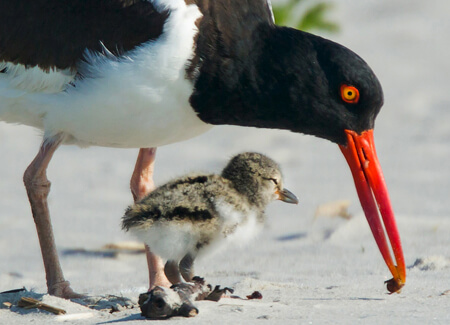 The flashy American Oystercatcher was once known as the "sea pie," but it was renamed in 1731 when naturalist Mark Catesby observed the bird eating oysters. This is one of the few bird species that specializes in feeding on saltwater mollusks.
The flashy American Oystercatcher was once known as the "sea pie," but it was renamed in 1731 when naturalist Mark Catesby observed the bird eating oysters. This is one of the few bird species that specializes in feeding on saltwater mollusks.
The oystercatcher opens mollusks by stabbing its flat bill into partially open shells and severing the muscles that hold the shell together, allowing the bird to eat the soft inner parts. The bird also uses its bill to hammer a mollusk's shell until it cracks.
Scrapes on the Shore
The shorebirds' nests are shallow scrapes on sandy or rocky ground along the shore. Although oystercatcher eggs are well camouflaged, they are vulnerable to predation by raccoons, coyotes, skunks, gulls, crows, rats, and foxes.
Chicks can run within 24 hours of hatching; however, it takes up to 60 days for their beaks to become strong enough to pry open bivalves, so they rely on their parents to feed them for their first few weeks.
Oystercatchers are typically short-distance migrants. Breeding birds from South Carolina to Florida generally do not migrate, but will leave breeding territories to join local roosting flocks during the non-breeding season.
Sign up for ABC's eNews to learn how you can help protect birds
Sharing the Beach

American Oystercatcher by Elliote Rusty Harold, Shutterstock
American Oystercatchers were nearly hunted to extinction in the 19th century for their plumage and eggs, but populations recovered well after passage of the Migratory Bird Treaty Act in 1918. The North American population is included on the 2014 State of the Birds Watch List, and several states consider it a species of concern.
Major threats still faced by this eye-catching shorebird include habitat loss from coastal development, climate change, and human disturbance. Trash, particularly plastics, creates a particular hazard for the American Oystercatcher, as the birds often mistake it for food, with fatal results.
ABC's beach-nesting bird conservation program works with partners to help identify, protect, and monitor important nesting areas for American Oystercatchers and other beach-nesting birds such as Least Tern, Snowy Plover, and Black Skimmer. This program also reaches out to educate vacationers about coastal nesting birds, including how to recognize breeding birds and avoid disturbing them on beaches.
In late 2020, ABC and partners started the SPLASh (Stopping Plastics and Litter Along Shorelines) program to address trash pollution problems along Texas's coast. This program conducts community cleanups and raises awareness of the problem through education and outreach programs.
Donate to support ABC's conservation mission!



















































